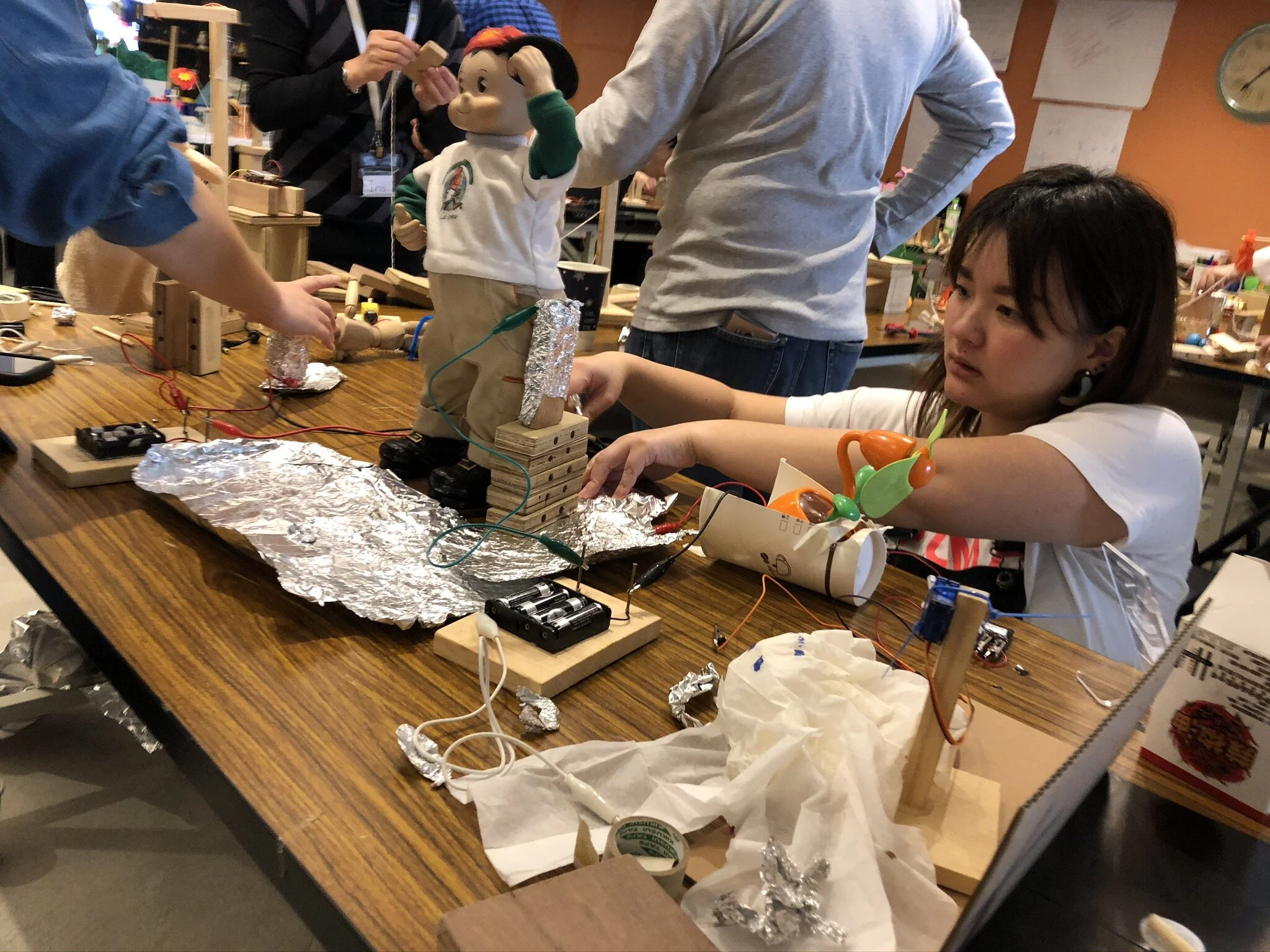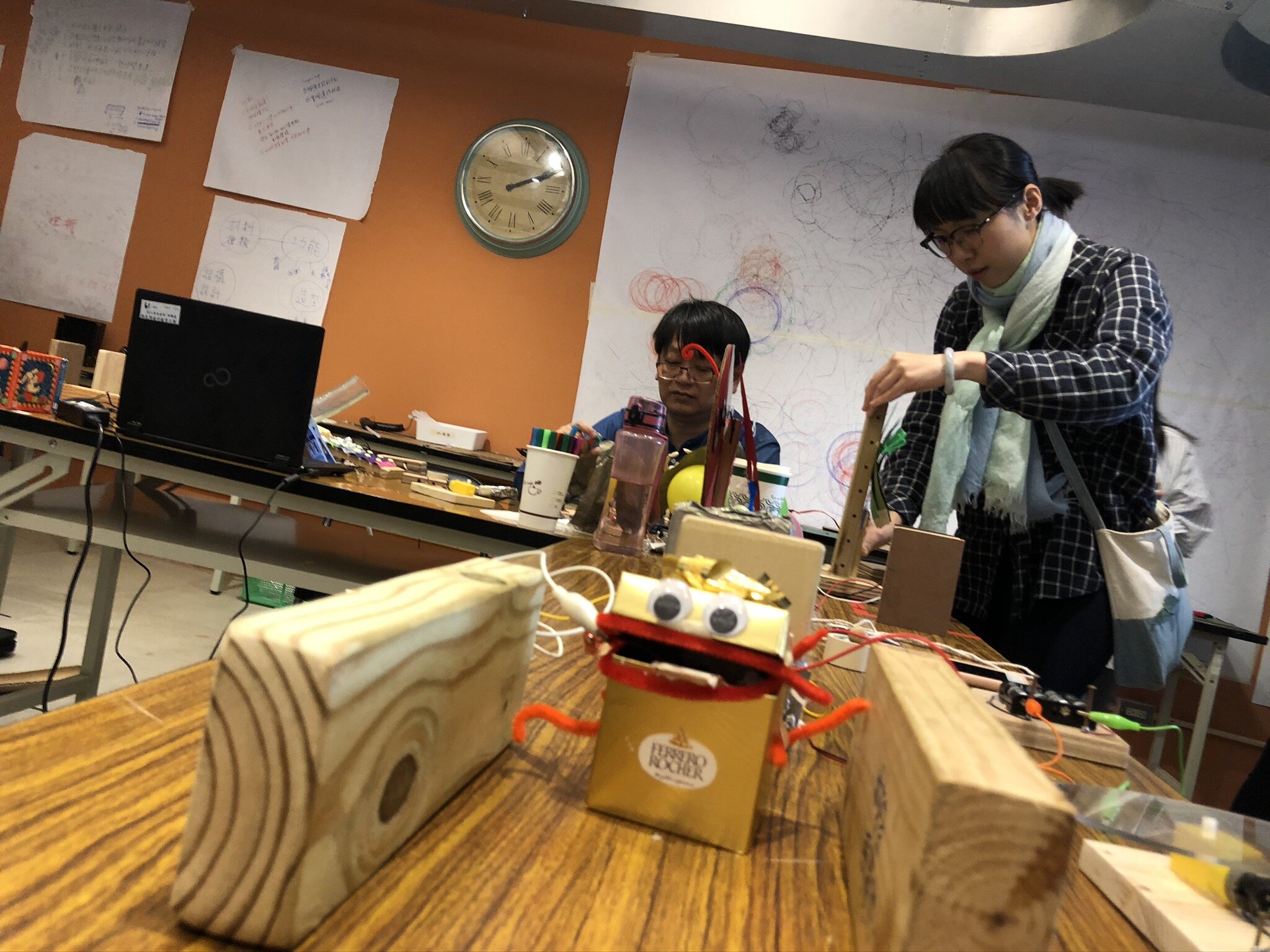Computational Tinkering Workshop at NTSEC
Over the past couple of years, we’ve been working on a three-day professional development workshop on computational tinkering, a playful, collaborative and open-ended approach to digital tools. In the latest iteration, Saskia Leggett, Jaleesa Trapp and I shared some experimental activities and organized discussions with a group of educators, designers and advocates from NTSEC (National Taiwan Science Education Center).
A couple days before the start of the workshop, we arrived in Taipei and started to set up a mini shop in the prototyping factory (a tinkering space adjacent to the museum). We organized a collection of physical and digital materials around the workshop space.
For the first activity of the workshop we went for an ‘analog’ activity to get the group started thinking about the learning outcomes in a tinkering experience. Participants spend about an hour building art machines using batteries, DAGU gear box motors and a wide variety of different shaped laser cut hubs.
We could tell right away that this group was serious about tinkering as well as character design as the scribbling machines had some really cute and unique designs.
In the afternoon of the first day of the workshop we started on our first computational tinkering activity. Groups worked to animate a shared value using scratch and makey makey. We had identified some of our values at the beginning of the day and this was a really cool prompt to get people thinking about possibilities to create personally meaningful projects with code.
It was really fun to see how some of the projects included elements where people touched, hugged or bumped hips. These interactive projects were super collaborative and imaginative in the ways that they combined the physical and digital worlds.
There was a lot of experimenting and testing with the programming as well. We printed out “scratch cards” with different tutorials for those who wanted a more guided approach, but others who just wanted to tinker with the code could explore the blocks, sprites, stages and other elements at their own pace.
At the end of the day we reflected together about the learning outcomes of tinkering and how computation can complicate and energize the process.
On the second day of the workshop we introduced Micro:bit, an approachable microcontroller that allows learners to program physical inputs and outputs digitally. The first activity that we tried was using the Micro:bit with Scratch to create interactive digital pets. The Micro:bit has an on board accelerometer that can detect when you tilt, shake, drop or hit the device.
It was so much fun to see the humor and collaboration from the group as they created projects ranging from lonely hedgehogs to playful dinosaurs to hungry bears to emotionally unavailable jellyfish. Both during the construction time and at the end of the workshop participants had a lot of fun sharing their work with each other and telling the funny stories behind their projects.
For the afternoon activity we introduced coding with MakeCode, another platform for the Micro:bit that allows you to control outputs like lights and motors as well as detach the board from the computer. For the activity we built some stands with positional servos (little programmable motors) that groups could use to create a sensor garden.
It was a lot of new information to pass along to the group but after some guided demos, free time to explore and help from the facilitators, There were some really cool ideas around the room mixing craft materials with the digital world.
On the last day of the workshop we started with a discussion of the 4 Ps as defined by Mitchel Resnick in the book Lifelong Kindergarten. We split up the group with each person getting either parts, purposes, play or peers and then forming a group with the other topics and discussing together. It was a really nice way to synthesize the ideas from the first two days of the workshop.
And for the bulk of the last day, we introduced the ideas of an experimental computational chain reaction where each pair added a digital element to their part of the rube goldberg esque machine.
I loved seeing the combination of the weird and wild chain reaction materials paired with the laptops, Micro:bit and the wide range of computational elements.
Some of the groups worked on some really precise mechanisms and others used the prompt to animate story-telling objects. And other groups incorporated elements from previous workshops like the art machines or digital pets into the contraptions.
At the end of about three hours of working the groups went around the room and showed off their machines, the code behind the digital devices and the story of the machine. There were some hilarious descriptions and many connections between different tables.
Here’s the video of the final set of off the machine! It was awesome to see how well this prototype activity worked and we’re excited to continue to develop the idea further.
Saskia Jaleesa and I had an amazing time working with the entire team at the NTSEC. It’s not usual that the group in a tinkering workshop included staff ranging from educators to operations managers to the director general and it was great to get everyone’s perspective on these new activities. I’m excited to see how the museum builds on these computational tinkering experiments in the coming months and years.



























